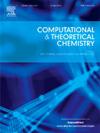Cutting-edge DFT-driven design of end-capped acceptor-modified hole transporters: Unraveling next-generation optoelectronic properties for high-performance perovskite photovoltaics
IF 3
3区 化学
Q3 CHEMISTRY, PHYSICAL
引用次数: 0
Abstract
Perovskite solar cells (PSCs) hold great promise in solving global energy issues. In this study, we present a novel method for improving PSC performance by designing and synthesizing seven extremely effective hole transport layer (HTL) molecules, identified as A2D1–A2D7. This approach incorporates acceptor groups into a planar anthracene with triphenylamine (TPA) side chains through thiophene bridges, improving the materials' optoelectronic properties for PSC applications. These customized HTL molecules display low exciton binding energies (ranging from -0.483 to -−0.082 eV), signifying efficient charge separation and transport. Optical analysis shows narrow energy gaps (between 1.02–1.76 eV) and broad absorption across the visible spectrum, which boosts light harvesting and photocurrent generation in PSCs. The molecules also exhibit low hole reorganization energies (0.0072442–0.0092753 eV). These findings provide fresh insights into the design of anthracene-based HTL molecules. This work offers a promising approach for developing high-performance materials for next-generation solar technologies.

尖端dft驱动的端封受体修饰的空穴转运体设计:揭示高性能钙钛矿光伏的下一代光电特性
钙钛矿太阳能电池(PSCs)在解决全球能源问题方面具有很大的前景。在这项研究中,我们提出了一种通过设计和合成7个极有效的空穴传输层(HTL)分子来提高PSC性能的新方法,鉴定为A2D1-A2D7。该方法通过噻吩桥将受体基团结合到具有三苯胺(TPA)侧链的平面蒽中,从而改善了PSC应用中材料的光电性能。这些定制的HTL分子显示出较低的激子结合能(范围从-0.483到- - 0.082 eV),这意味着有效的电荷分离和传输。光学分析表明,PSCs的能隙窄(在1.02-1.76 eV之间),在可见光谱上吸收宽,这促进了光收集和光电流的产生。分子也表现出较低的空穴重组能(0.0072442-0.0092753 eV)。这些发现为基于蒽基的HTL分子的设计提供了新的见解。这项工作为开发下一代太阳能技术的高性能材料提供了一种很有前途的方法。
本文章由计算机程序翻译,如有差异,请以英文原文为准。
求助全文
约1分钟内获得全文
求助全文
来源期刊

Computational and Theoretical Chemistry
CHEMISTRY, PHYSICAL-
CiteScore
4.20
自引率
10.70%
发文量
331
审稿时长
31 days
期刊介绍:
Computational and Theoretical Chemistry publishes high quality, original reports of significance in computational and theoretical chemistry including those that deal with problems of structure, properties, energetics, weak interactions, reaction mechanisms, catalysis, and reaction rates involving atoms, molecules, clusters, surfaces, and bulk matter.
 求助内容:
求助内容: 应助结果提醒方式:
应助结果提醒方式:


